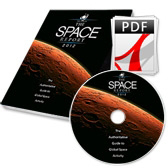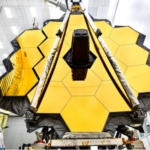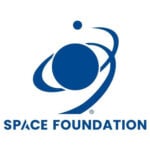Space Foundation Press Releases
Now on Sale, The Space Report 2012: The Authoritative Guide to Global Space Activity Covers 2011 Space Performance; Provides Outlook for Future
Written by: developer
 COLORADO SPRINGS, Colo. (April 5, 2012) — Published by the Space Foundation, The Space Report 2012: The Authoritative Guide to Global Space Activity is the definitive annual overview of the global space industry and serves as a valuable resource for government and business leaders, educators, financial analysts, students and space-related businesses.
COLORADO SPRINGS, Colo. (April 5, 2012) — Published by the Space Foundation, The Space Report 2012: The Authoritative Guide to Global Space Activity is the definitive annual overview of the global space industry and serves as a valuable resource for government and business leaders, educators, financial analysts, students and space-related businesses.
The book details how the global space economy grew to $289.77 billion in 2011, reflecting a surprisingly robust single-year expansion of 12.2 percent and five-year growth of 41 percent* in a global economy that has been suppressed in many other sectors. The Space Report 2012 was released to the news media today and will be released to the general public at the 28th National Space Symposium.
About the Book
The 164-page book contains worldwide space facts and figures and is illustrated with photographs, charts and graphs. PDF and CD-ROM versions include hyperlinks to the companies, organizations, reports and references mentioned in the text.
The book is divided into five sections: Space Products and Services, the Space Economy, Space Infrastructure, Workforce and Education and an Outlook for the future. Within those chapters are myriad examples of the benefits of space exploration and utilization, the challenges facing the space sector, the opportunities for future growth and the major factors that shape the industry. In addition, The Space Report includes an overview of each sector, easy-to-understand definitions and up-to-date information on space infrastructure, facilities, launches and programs.
Section 1 — Space Products and Services
This section includes information on:
- How a space spinoff gets created, such as how a water purification system originally developed for use on the Space Shuttle has been adapted to provide clean drinking water for hundreds of villages in under-developed parts of the world
- How space products and services are used
- Products and services about space, in addition to ones that come from space activity, such as NASA’s Eyes on the Solar System tool that allows people to explore the universe from their home computers — accessing data collected by NASA spacecraft
- Emerging technologies, such as small, inexpensive satellites that can be used for specific missions
- Measuring the impact of spinoffs
Section 2 — The Space Economy
This section, considered the definitive global analysis of the entire space economy, covers a wide range of factors contributing to the $289.77 global space economy and the 12.2 percent increase over 2010. It details:
- Commercials space products and services, which are the real drivers of growth, especially GPS devices and chipsets and direct-to-home (DTH) television
- Governmental space spending, which increased worldwide by 6 percent with significant variation among nations
- An overview of how the budget data were collected and compiled
- The outlook for investment data
- How commercial space companies’ stocks out-performed the marketplace in 2011
Section 3 –Space Infrastructure
This section looks at launch vehicles, space stations, satellites, ground stations, spaceports, observatories, robotic exploration stations and technology development. Highlights include:
- In 2011, there were 84 launches, an increase of 14 percent over 2010; Russia led with 31, China had 19 and the U.S. totaled 18, the first time that Chinese launches exceeded that of the United States
- At the end of 2011, there were an estimated 994 active satellites in orbit around the Earth
- Among the top 25 fixed satellite services operators by revenue, only one is based in the U.S.
Section 4 — Workforce and Education
This section explores workforce statistics and education trends that affect the ability to create a skilled workforce. There are chapters on U.S., European, Japanese and Korean space employment plus information on the entire global workforce. Key points include:
- The U.S. space workforce declined for the fourth year in a row, dropping 3 percent from 259,996 in 2009 to 252,315 in 2010 (the most recent year for which data is available); this was the second-lowest employment level recorded during the previous ten years; conversely, both Europe and Japan saw increases in their space workforces
- The U.S. military space workforce was 16,739 in 2011, a 6 percent increase from 2009; the Air Force workforce grew by 8 percent, while the Navy space workforce declined by 5 percent
The chapter also looks at global space education, including an in-depth look at primary school math and science proficiency, quoting the newest — an slightly improved – numbers from U.S.-specific and worldwide exams.
Section 5 — Outlook
The book concludes with an Outlook section that, this year, focuses on four thematic areas reflecting important trends in space activity:
- Changes in the trajectory of human spaceflight
- National budget austerity that leads to programmatic uncertainty
- The maturing relationship between government and commercial space
- Increasingly prevalent and diverse partnership models
Media Briefing
The Space Foundation will hold a media briefing on The Space Report 2012 at the 28th National Space Symposium on Wednesday, April 18, from 10:15-11:00 a.m. in the Space Foundation Media Center on the second floor of Broadmoor Hall at The Broadmoor Hotel in Colorado Springs, Colo. Reporters may also call in to 866-330-1200 and use passcode 5768000#. The briefing will feature Space Foundation Director – Research and Analysis and The Space Report Program Manager Micah Walter-Range, Futron Corporation Senior Analyst Dustin Kaiser and ISDR Consulting, LLC, Managing Director Kevin Leclaire.
For more details, contact [email protected] or inquire onsite at the Media Center.
Introductory Savings until May 1
Until May 1, The Space Report can be purchased — in print, on CD-ROM or as a downloadable PDF – for $69.50, a 50 percent discount off the list price. Purchases can be made online at www.TheSpaceReport.org or onsite at 28th National Space Symposium. Multi-user licenses for schools and businesses, academic pricing and discounted previous editions of The Space Report are also available via online purchase. The book is a “green” publication; the materials used in the processes for printing The Space Report 2012 have been certified as meeting the standards and requirements of the Forest Stewardship Council (FSC).
About the 28th National Space Symposium — and Symposium Book Signings
The Space Foundation’s National Space Symposium is the premier gathering of the global space community.
A new feature at the Symposium is a series of book signings featuring authors:
- Dr. G. Scott Hubbard, Exploring Mars: Chronicles from a Decade of Discovery
- P.J. O’Rourke, Don’t Vote, It Just Encourages the Bastards
- Dr. Neil deGrasse Tyson, Space Chronicles: Facing the Ultimate Frontier
- Mark Stevenson, An Optimist’s Tour of the Future
- Dr. Lisa Randall, Knocking on Heaven’s Door: How Physics and Scientific Thinking Illuminate the Universe and the Modern World
- Fred Ledley, Sputnik’s Child
- William Scott, Space Wars: The First Six Hours of World War III and Counterspace: The Next Hours of World War III
For details, click here.
About the Space Foundation
The foremost advocate for the space industry and an expert in all aspects of space, the Space Foundation is a global, nonprofit leader in space awareness, educational programs that bring space into the classroom and major industry events, including the National Space Symposium, all in support of its mission “to advance space-related endeavors to inspire, enable and propel humanity.” Through its Space Certification and Space Technology Hall of Fame® programs, the Space Foundation recognizes space-based technologies and innovations that have been adapted to improve life on Earth. Founded in 1983 and headquartered in Colorado Springs, the Space Foundation conducts research and analysis and government affairs activities from its Washington, D.C., office and has a field office in Houston, Texas. For more information, visit www.SpaceFoundation.org. Follow us on Facebook, LinkedIn and Twitter, and read about the latest space news and Space Foundation activities in Space Watch.
# # #
* Note: The 12.2 percent increase is calculated on a 2010 total of $258.21 billion, which has been adjusted from The Space Report 2011. Updates and methodology changes include addition of EUMETSAT, Kazakhstan and Ukraine budget data; and inclusion of NRO and NGA budgets in the DOD budget estimate.


